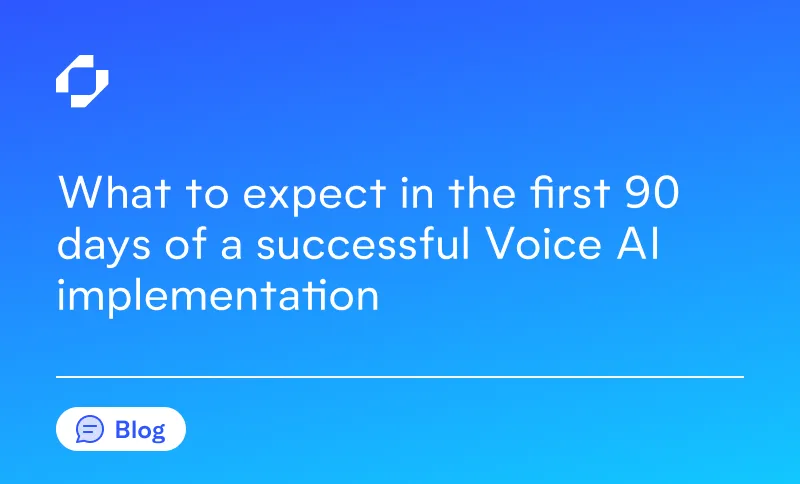Quick Summary
Are you evaluating Interactions as a conversational AI solution? Our guide spotlights 10 top alternatives that excel in voice automation, AI-powered chat, and enterprise-scale deployment. You’ll learn the key features, pricing, pro’s and con’s for Interactions competitors including Replicant, Kore.ai, Cognigy, Google Dialogflow, Amazon Lex, Amelia, Observe.ai, Five9 IVA, Microsoft Bot Framework and LivePerson.
Whether you're focused on reducing agent workload, boosting customer satisfaction, or deploying solutions quickly, this comparison will help you identify the best conversational AI platform for your needs.
Considering Replacing Interactions?
Interactions has a long-standing reputation powered by their patented Human Assisted Understanding (HAU) system, blending conversational AI with human oversight. Still, some organizations look elsewhere because of:
- Desire for platforms that are fully voice-native with less manual supervision
- Faster time to deploy with out-of-the-box use cases
- Transparent pricing without enterprise packaging
- Integration-ready systems that plug into modern contact center tech
- Options with a lighter footprint than massive contact-center suites
If your goal is agility, simplicity, or speed, you may want to look at certain Interactions competitors who might be a better fit.
Why Trust Our Recommendations?
Replicant has delivered voice-first automation at scale since 2018. We’ve handled half a billion minutes of calls across industries such as retail, healthcare, consumer services, insurance, and financial services. We combine managed deployment with ongoing optimization, ensuring solutions launch quickly and improve over time.
This real-world experience allows us to assess platforms not just on features, but on long-term impact, reliability, and customer results.
What Is Interactions?
Interactions offers an intelligent virtual assistant platform backed in AI research on real-time intent detection and support escalation. Their platform includes AI-powered agent assist with compliance redaction and generative AI elements from data in speech flows.
Despite its sophistication, enterprise-grade complexity is baked into the platform, which helps explain why organizations consider alternative platforms with a more streamlined path to value.
Limitations of Interactions
Although widely used by enterprises, common concerns include:
- Heavy hybrid model: Their HAU system often requires live agent oversight
- Extended implementation cycles: Custom integrations and tuning take time
- Large support teams required: Ongoing management often needs vendor services
- Costly for smaller deployments: Packaged for global-scale operations
- Less flexibility with new telephony tech: Built as a suite vs modular components
If you're focused on fast implementation, lower resource demands, and streamlined pricing, one of the following platforms might be a better match.
Top 10 Interactions Alternatives
Read on to learn more about the following 10 top Interactions alternatives:
- Replicant
- Kore.ai
- Cognigy
- Google Dialogflow
- Amazon Lex
- Amelia
- Observe.ai
- Five9 IVA
- Microsoft Bot Framework
- LivePerson
1. Replicant
Replicant delivers a dual-powered Conversational AI platform that outperforms Interactions in complex contact center environments. Unlike Interactions' more traditional approach, Replicant offers two integrated solutions: Conversation Automation handles end-to-end customer interactions without human intervention, while Conversation Intelligence extracts actionable insights from every conversation using multi-modal large language models.
Where Interactions often requires human assistance for complex scenarios, Replicant excels at managing multi-turn conversations across voice, chat, and SMS with a hyper-realistic voice that is natural in customer conversations. This comprehensive approach allows contact centers to not just partially automate calls like Interactions, but fully resolve customer inquiries while simultaneously gathering intelligence to improve both automated and human agent performance. Replicant provides a mature, scalable solution designed specifically for the nuanced demands of modern contact centers.
Key Features
- Voice-centric flow management that is capable of full conversation handling
- SMS and web chat coverage for multichannel reach
- Instantly reflects CRM data with seamless sync and robust integrations
- User-editable flows via a low-code interface
- Insight through Conversation Intelligence that uncovers analytics and performance over time
Pricing
Replicant offers customized pricing that vary based on call volume and integrations.
Pros
- Built specifically for voice with robust chat and SMS capabilities.
- Fast-track deployments in 30–60 days
- Hybrid deployment and managed services included
- Proven voice reliability at scale
Cons
- Best suited for enterprise and upper mid-market environments
👉 Learn more about Replicant’s Conversation Automation
👉 Request a demo
2. Kore.ai
Kore.ai offers a powerful bot-building platform designed for enterprises, with NLU, omnichannel deployment, and deep analytics.
Key Features
- Visual flow designer and multi-bot orchestrator
- Supports voice calls, messaging, and digital chat
- Analytics dashboards for performance and intent tracking
- Pre-configured vertical templates
Pricing
Enterprise-based quotes depending on scale and module selection.
Pros
- Highly customizable architecture
- Rich enterprise use cases supported
- Data-driven analytics and insights
Cons
- Requires engineering-heavy rollout
- Voice-first use may need extra configuration
- May take months to fully deploy at production levels
3. Cognigy
Cognigy’s low-code platform is built for global scalability and compliance, making it a solid choice for enterprises.
Key Features
- Drag-and-drop flow creation
- Full speech and text channel support
- Strong localization tools, with 30+ languages
- Telephony integration and contact center connectors
Pricing
Tiered licensing where scope and scale drive the quote.
Pros
- Great for multi-country, multilingual use cases
- Developer-extensible with API and webhook connections
- Proven in finance, travel, and healthcare
Cons
- Visual interface is more technical than newer SaaS
- May require implementation partners for full setup
- Scaling across voice channels needs IT involvement
4. Google Dialogflow
Dialogflow CX, from Google Cloud, excels at modeling conversational flows with deep AI backing.
Key Features
- Multi-turn design with memory and context
- Leverages Google’s AI for NLU capabilities
- Template agents and reusable components
- Cloud-native reliability and security
Pricing
Usage-based pricing tied to sessions and interactions.
Pros
- Strong NLP with Google engine underpinnings
- Easy integration with Google Contact Center AI
- Suited for complex dialog structures
Cons
- Developer skill required for voice deployment
- Voice may need extra tuning layers
- Support primarily self-serve unless under higher-tier plans
5. Amazon Lex
Part of AWS, Amazon Lex offers bots with speech recognition and integrates across cloud services.
Key Features
- ASR and intent understanding powered by AWS
- Native integration with Lambda, DynamoDB, and more
- Multilingual bot support
- Pay-as-you-go scalability
Pricing
Per-request billing model where costs vary by usage.
Pros
- Ideal for AWS-aligned infrastructure teams
- Broad language SDK and API support
- Supports serverless and custom logic
Cons
- Setup requires engineering expertise
- UI is developer-centric
- Lacks studio-like flow builder
6. Amelia
Amelia blends conversational AI with RPA, enabling agent-like interactions combined with backend workflows.
Key Features
- AI + RPA-driven task automation
- Sentiment-aware and context-tracked dialogues
- Voice and messaging across channels
- Strong compliance and auditability
Pricing
Amelia offers custom enterprise pricing.
Pros
- Ideal for orchestrating multi-system workflows
- Suitable for highly regulated environments
- Robust enterprise feature set
Cons
- Lengthy implementation cycles
- Requires extensive IT and change-management effort
- Higher total costs compared to SaaS-first platforms
7. Observe.AI
Observe.ai focuses on call monitoring, quality assurance, and real-time coaching, although they recently launched voice bots as well.
Key Features
- AI-assisted QA and compliance scoring
- Live-agent recommendations during calls
- Conversation analytics and sentiment tracking
- Integrates with major contact center platforms
Pricing
Customized quotes based on deployment requirements.
Pros
- Drives agent improvement and compliance insights
- Scalable across large call centers
- Easy to pair with voice automation platforms
Cons
- Not a standalone voice bot tool
- Requires complementary voice automation solution
- Intensive setup for analytics calibration
8. Five9 Intelligent Virtual Agent (IVA)
Five9 IVA is the voice automation offering within the Five9 contact center platform. It enables enterprises to deploy conversational AI for customer service, support, and self-service use cases.
Key Features
- Prebuilt voice applications for common workflows
Integrated with Five9's cloud contact center suite - Visual design tools for call flows
- Supports natural language interactions across voice and chat
Pricing
Typically bundled with the broader Five9 CX platform; pricing depends on seats and modules used.
Pros
- Built-in to a leading CCaaS platform
- Voice-specific features and telephony support
- Helpful for teams already using Five9 for agents
Cons
- Closed ecosystem; best for existing Five9 users
- Customization and tuning often require Five9 partners
- Not a standalone automation tool
- Time to deploy can vary significantly based on setup complexity
9. Microsoft Bot Framework
Microsoft Azure AI Bot Service enables deep customization for enterprise scenarios.
Key Features
- Developers-first framework with SDK support
- Integrates with Azure Cognitive Services
- Omnichannel support via Azure Bot Service
- Self-hosted and secure deployment models
Pricing
Dependent on Azure resource usage.
Pros
- Great fit for Microsoft-centric stacks
- Infinite customization possibilities
- Can be deployed on-prem or in Azure cloud
Cons
- Requires heavy developer involvement
- No built-in conversation intelligence tools
- Voice must be built or connected manually
10. LivePerson
LivePerson offers conversational AI and messaging platforms that help brands automate interactions across web, mobile, and messaging apps. It’s well known for its digital engagement tools and AI-powered chat solutions.
Key Features
- Real-time messaging across SMS, chat, and social apps
- Conversational AI for intent detection and automation
- Integrations with CRMs and agent platforms
- Customizable bots with human-in-the-loop workflows
Pricing
Custom pricing based on volume and use case; typically tiered by conversation count and AI usage.
Pros
- Well-established in digital-first customer support
- Strong brand recognition and enterprise adoption
- Scalable for high-volume use cases
Cons
- Primarily chat/messaging focused, voice is limited
- Not purpose-built for contact center-grade telephony
Automation setup may require consulting services - Higher cost for teams not needing full digital engagement suite
Choose the Best Interactions Alternative: Replicant
Interactions delivers strong intelligent virtual assistant capabilities, backed by patented systems and enterprise-grade features. However, for organizations pursuing true voice automation with minimal human handoff, Replicant is built to lead.
Our platform empowers contact centers to launch voice-first automation in about 60 days, covering full inbound call handling without live agents. It also includes Conversation Intelligence, delivering actionable insights and ongoing optimization.
Replicant offers a comprehensive, enterprise-quality solution that's simpler to adopt, faster to launch, and more scalable across industries and use cases.
Request a demo to learn how Replicant delivers real results through voice AI and automation excellence.






